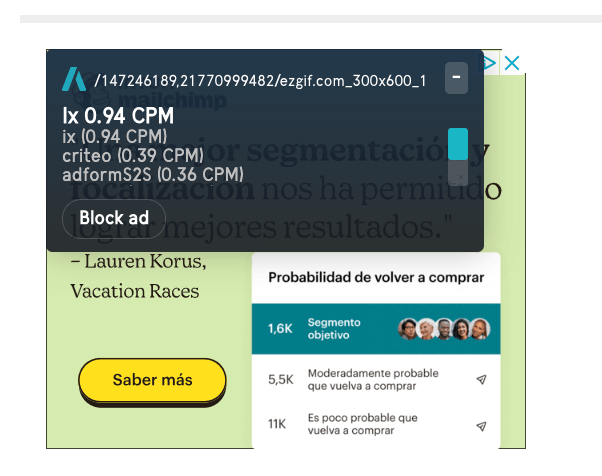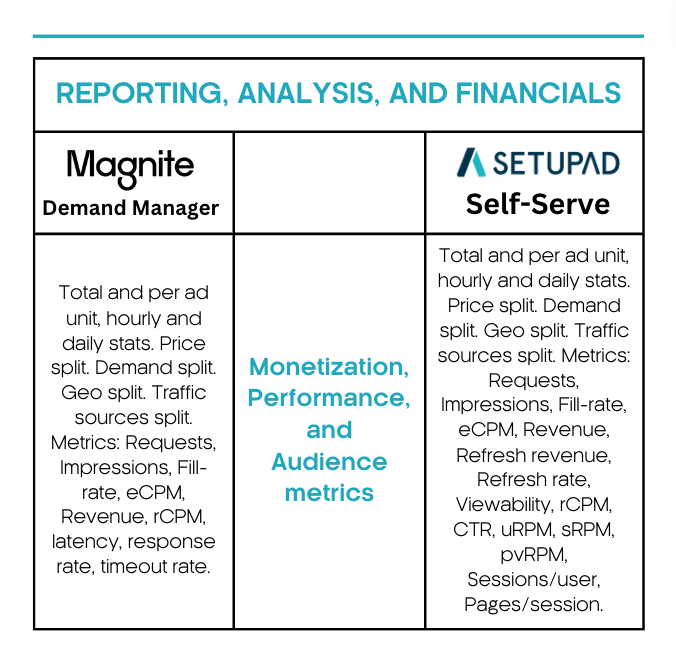Setupad Self-Serve vs. Magnite Demand Manager: A Comparison
In the fast-paced world of digital advertising, new buzzwords seem to pop up every day–Prebid Management Platform, Prebid as a Service, Self-Service/Self-Serve Platforms—you’ve heard them all.
But let’s cut through the noise: these terms all boil down to the same powerful concept. They represent a new generation of platforms designed to offer enterprise-level management tools while giving publishers the ultimate control over their header bidding processes.
Two such solutions are Setupad Self-Serve and Magnite Demand Manager.
This article delves into a comparative analysis of these two platforms, focusing on infrastructure, onboarding, customization, analytics and financials to help you determine which platform aligns best with your needs.

1. Infrastructure and Technology
Wrapper compression and size
Magnite Demand Manager offers a robust infrastructure characterized by frequent updates to new and stable Prebid versions. It employs Gzip for wrapper compression and allows local hosting via Apache. Notably, Demand Manager supports a minimum wrapper file size of 144KB, which increases with the integration of each additional SSP.
Conversely, Setupad Self-Serve emphasizes a streamlined approach with a minimum file size of 100kB and maximum file size of 140kB with 30+ SSPs. It utilizes Brotli compression, a newer compression algorithm that generally provides better compression ratios, which means faster load times and improved performance for end-users.
Demand
The most significant distinction is that Setupad Self-Serve provides an option to integrate additional demand through direct connections with over 30 leading SSPs, applicable to both browser-side and server-side setups (commission fee applies). In contrast, Magnite does not provide the option to expand your list of demand partners aside from publishers’ own bidders.
Anti-malvertising software
Setupad Self-Serve comes with a built-in anti-malvertising software (Boltive) and cloud-based hosting Azure and Cloudflare for enhanced scalability and faster response times. This emphasis on simplicity and security makes Self-Serve a strong contender for those prioritizing stability and security.
Prebid Server
Both Magnite and Setupad also simplify the integration of Prebid Server by hosting the server-side infrastructure inside their platforms. By offering a streamlined Prebid Server solution, they empower publishers to maximize programmatic demand and improve user experiences.
2. Onboarding Experience
The onboarding process can often be a determining factor for many publishers. Some self-service solutions require more hands-on management, while some are completely automated. Even when claimed to be fully self-service, publishers may often encounter steps that can only be done by the vendor’s Account Managers.
GAM initialization
Setupad’s automated Prebid initialization takes only 40 minutes and seamlessly imports existing ad units from Google Ad Manager (GAM). Once the structure from GAM is imported and setup is complete, publishers can start managing ad units and performing optimization straight away.
Whether it’s adjusting timeouts, ad sizes, size mapping, and refresh rates or managing SSPs—such as adding new partners or migrating from browser to server-side—Setupad streamlines the entire process, providing publishers full independence from IT. This saves valuable time that can be redirected towards implementing more sophisticated and frequent adjustments to optimize advanced Prebid configurations.
As part of its onboarding, Setupad platform offers publishers to configure a Google-approved and IAB-certified Setupad CMP, a free product built to gather user consent seamlessly and transparently. Besides, Setupad encourages publishers to set up ads.txt redirect solutions, to ensure any changes made to the ads.txt file will be automatically included in the redirected ads.txt file.
In contrast, Magnite’s onboarding process is more hands-on. Initially, the publisher must complete an onboarding Google Sheet specifying their preferred wrapper configurations. After approximately two weeks, access is provided to a pre-configured panel. However, the process can be quite complex, requiring the creation of custom media objects for each ad unit with specific sizes, as well as the manual addition of SSP adapters and Google Ad Manager configurations.
While Demand Manager offers a comprehensive Prebid service, it’s not truly a self-serve tool, as many custom settings are still managed through email communication with the Account Manager, necessitating more extensive IT involvement. Changes cannot be implemented independently and, in most cases, require IT assistance.
3. Customization Capabilities
Customization capabilities are essential for these types of platforms because they allow publishers to tailor their ad strategies to their unique needs, offering flexibility to adapt to market changes and optimize performance. Customization helps maximize revenue by enabling continuous testing and iteration of various bidding configurations.
Setupad allows for extensive customization options, including smart ad refresh features, lazy loading, sticky functions, and adjustable timeouts—all without requiring code updates. It also provides built-in A/B testing per ad unit, targeting devices for responsive websites, desktop/mobile traffic for optimized SSP connections and GEO targeting capabilities, making it ideal for publishers looking for granular control over their ad strategies.
Besides, Setupad comes with a free Google Chrome extension for ad monitoring and blocking.

Magnite, meanwhile, offers a slightly different set of customization tools, emphasizing machine learning and AI. The new set of features includes one-click A/B testing, allowing publishers to compare machine-generated wrapper configurations with existing settings to see which performs better. The platform feeds in the data from ad server auctions and sessions to fine-tune Prebid settings dynamically. Additionally, Demand Manager enables you to incorporate custom third-party products, such as custom layout rules or ad block monetization, through its control center. However, active accounts with these tools are required for integration.
You have the flexibility to add specific bidders to each ad unit using a pre-configured pattern, although this approach tends to be quite manual. Alternatively, you can manage ad units in bulk by downloading an Excel template, making modifications, and importing it back—a process that also involves some manual effort.
A key distinction between Setupad Self-Serve and Magnite Demand Manager lies in their approach to Google Ad Manager (GAM) integration. With Setupad, your entire GAM structure is already defined, allowing you to easily select ad units and add SSPs directly. In contrast, Magnite Demand Manager requires additional steps, such as initiating line items and communicating them to GAM, which typically takes around 10 minutes.
Magnite Demand Manager also provides a web integration guide with code examples that must be implemented on the website. This requires IT involvement to define the code and integrate the necessary GAM configurations.
4. Reporting and Analytics
Reporting and analytics tools provide the necessary insights to optimize monetization, improve site performance, evaluate bidder success, ensure transparency, and tailor strategies to specific needs in Prebid environments.
When it comes to analytics, Magnite offers a comprehensive suite of tools, tracking key performance metrics such as requests, impressions, fill rate, eCPM, and revenue across multiple dimensions, including geographic location and traffic sources.
Setupad extends this with additional metrics like refresh revenue, viewability, and detailed performance analysis per ad unit, allowing for a more nuanced understanding of ad performance and audience behavior.
Below is a more detailed look on monetization, performance, and audience metrics differences between these two platforms.

Another notable mention is Setupad’s Yield Formula, a native tool that’s connected to the publisher’s GA4 and provides an overview of cumulative effect on 5 key metrics: users, loyalty, engagement, ads per page, and eCPM. The tool is great for those looking to tap into historical comparison and growth projection of the ad revenue over time.

Source: Setupad Yield Formula
5. Financial Considerations
Prebid management platforms often come with associated costs, such as platform fees, commissions on winning bids, and maintenance expenses. Understanding these financial components helps publishers balance the costs against potential revenue gains to ensure the solution is cost-effective.
Magnite operates on a 4% commission model on all winning bids, providing a clear and predictable pricing structure. Meanwhile, Setupad charges a 0.05 CPM, potentially offering a more cost-effective solution for publishers with high-volume traffic. The choice between the two will ultimately depend on the publisher’s specific needs and traffic profile.

Conclusion
Both Setupad Self-Serve and Magnite Demand Manager offer compelling features tailored to different aspects of digital advertising management. Overall, publishers should evaluate these options based on their specific requirements, technical capabilities, and strategic goals.


